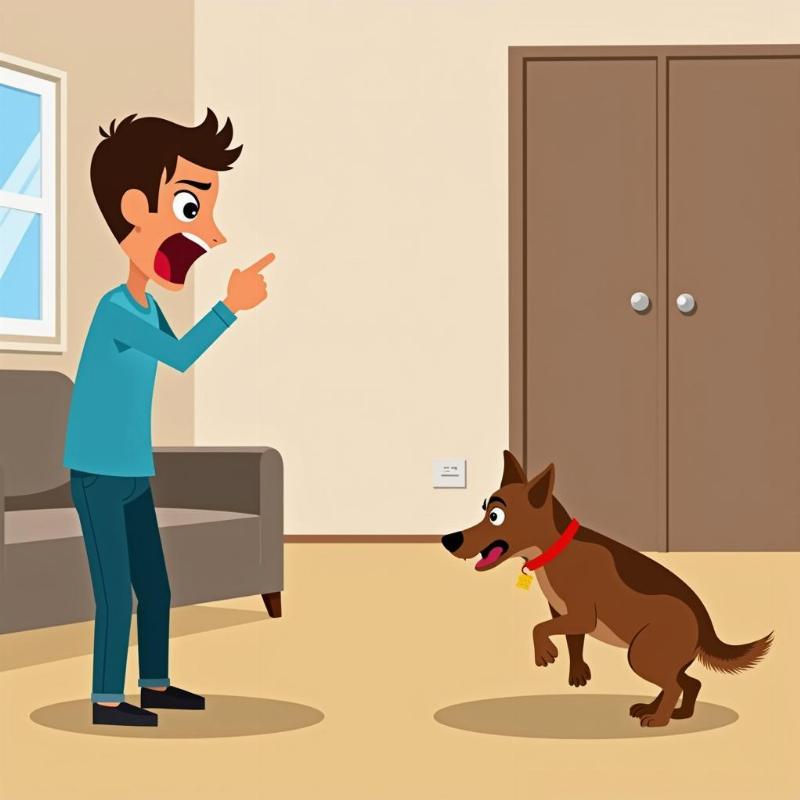Yelling at your dog. We’ve all been there, haven’t we? Frustration bubbles over, and suddenly your voice is raised. But does yelling at dogs work? The short answer is no. In fact, it can be detrimental to your relationship and your dog’s well-being. Let’s explore why yelling isn’t effective and what alternatives you can use to build a positive, rewarding relationship with your furry friend.
Why Yelling at Your Dog Is Ineffective
Yelling can seem like a natural response when your dog is misbehaving, but it’s rarely the right solution. Dogs don’t understand the nuances of human language. Instead of understanding what you’re saying, your dog primarily reacts to your tone of voice and body language. When you yell, your dog interprets it as aggression, fear, or confusion. This can lead to a number of negative consequences.
- Fear and Anxiety: A raised voice can frighten your dog and create anxiety, potentially leading to behavioral issues like aggression, submissiveness, or destructive behavior.
- Damaged Trust: Consistent yelling erodes the bond between you and your dog. Your dog might become less likely to trust you and may become withdrawn.
- Learned Helplessness: If yelling is your primary training method, your dog might learn to shut down and give up trying to understand what you want. This can make training even more difficult.
- Increased Stress: Both you and your dog experience increased stress when yelling becomes a regular occurrence. This can negatively impact your relationship and your overall well-being.
 Yelling at a dog creates fear and anxiety
Yelling at a dog creates fear and anxiety
Effective Alternatives to Yelling
Fortunately, there are many effective and humane ways to train your dog without resorting to yelling. These methods focus on positive reinforcement, clear communication, and consistency.
- Positive Reinforcement: Reward desired behaviors with treats, praise, or a favorite toy. This encourages your dog to repeat those behaviors.
- Clear and Concise Commands: Use short, simple commands that your dog can easily understand. Consistency in the words you use is key.
- Consistent Training: Regular, short training sessions are more effective than sporadic, long ones. Keep sessions positive and engaging.
- Body Language: Use clear body language to communicate with your dog. Hand signals and posture can be effective tools.
- Seek Professional Help: If you’re struggling with training, consider consulting a certified professional dog trainer. They can provide personalized guidance and support.
Understanding Your Dog’s Behavior
Before reacting to unwanted behavior, try to understand why your dog is acting that way. Is your dog bored, stressed, or needing attention? Addressing the underlying cause of the behavior can be more effective than simply punishing the symptoms.
Does a Stern Voice Ever Work?
While yelling is never recommended, a firm, low-toned “No” or “Leave it” can sometimes be effective in interrupting unwanted behavior. The key is to use it sparingly and consistently. This isn’t yelling, but rather a clear, assertive communication of disapproval.
Conclusion
Yelling at your dog is not an effective training method. It creates fear, damages trust, and ultimately hinders your ability to build a positive relationship. By focusing on positive reinforcement, consistent training, and clear communication, you can create a happy, well-behaved companion. Remember, patience and understanding are key to successful dog training.
FAQ
- Why does my dog seem to ignore me when I yell? Your dog is likely reacting to your tone and body language rather than understanding your words. Yelling can be perceived as aggression.
- What should I do instead of yelling when my dog misbehaves? Try redirecting your dog’s attention with a toy or treat, and reward good behavior.
- Can yelling cause long-term behavioral problems in dogs? Yes, consistent yelling can lead to anxiety, fear, and aggression.
- Is it ever okay to raise my voice at my dog? A firm, low-toned “No” can be used sparingly to interrupt unwanted behavior, but avoid yelling.
- How can I learn more about positive reinforcement training? Consult with a certified dog trainer or research online resources about positive reinforcement methods.
Beautdogs.us is your premier resource for all things dog-related in the US. We offer expert advice on dog breeds, care, and lifestyle, providing a trusted source of information for both new and experienced dog owners. Our expertise covers everything from puppy training to senior dog care, ensuring you have the knowledge to provide the best possible life for your furry friend. Connect with us today for personalized guidance! Email: [email protected], Phone: +1 501-555-7529. Visit Beautdogs.us for more helpful tips and resources!